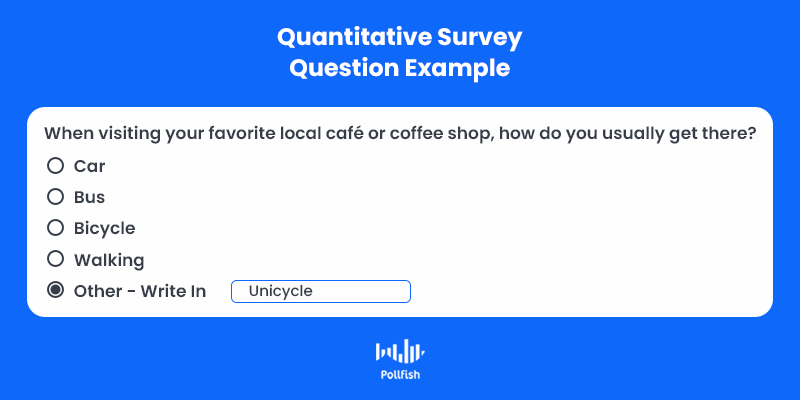Excelling in Survey Research with the Quantitative Survey

A quantitative survey provides researchers with data that is quantifiable in nature, making this type of survey an important component of any research project. In a quantitative survey, numeric values are assigned to the answers so researchers can objectively measure and compare survey data.
A quantitative survey produces the type of data that many of us associate with surveys. This type of data is easily converted into objective, numerical results that can be viewed in tables and charts to provide a clearer picture.
In “The Complete Guide to Quantitative Market Research,” we covered the types of quantitative research methods that are used to drive market research. In this article, we will focus specifically on how you can use a quantitative survey to gather numerical data to drive your research project.
Defining the Quantitative Survey

In a quantitative survey, data is obtained by asking respondents objective, close-ended questions. Each question has a predefined list of answers. The responses are then used to compile numerical data that you can analyze via tables, charts, and graphs.
Quantitative survey questions are used to gain insights about ratings, pricing, frequency, and likelihood. They are often used to understand the relationship between attitudes and consumer behavior. The responses for quantitative survey questions include binary, multiple-choice, and scaled responses.
One of the main ways that a quantitative survey differs from a qualitative survey in that it asks “who” and “what,” while qualitative questions ask “why,” in order to understand the motivation behind actions, thoughts, or feelings. Qualitative questions are commonly used to gain context or gather information about attitudes, lifestyle choices, and issues. The responses for qualitative questions involve both open-ended and multiple-choice questions.
The Pros and Cons of Quantitative Surveys
In order to understand when to use quantitative surveys, you must first understand the pros and cons of this type of survey.
The Pros:
- The data from quantitative surveys is usually easy to collect and analyze.
- The simple format of quantitative surveys allows researchers to distribute them more broadly and reach a larger audience.
- Without open-ended questions, quantitative surveys are usually faster to complete, which can improve the response rate.
- Quantitative surveys are useful when researching sensitive subjects because they can allow the respondent to remain completely anonymous, without the need to contribute any personal or identifiable information.
- Quantitative surveys are more mobile-friendly than qualitative survey questions because the respondent does not need to type out lengthy answers.
The Cons:
- Quantitative surveys do not allow researchers to probe for deeper or unique answers to survey questions.
- The results of quantitative surveys can be misleading. Despite the seemingly objective nature of quantitative surveys, researchers can interpret the data based on their own views and then state conclusions in a way that sounds factual since they are based on numbers.
- Since quantitative survey questions have predefined responses, there is no opportunity for a respondent to volunteer unexpected information.
- It can take longer to plan a good quantitative survey that will collect the data needed to understand relationships or behavior.
- Survey responses must be carefully considered so that respondents are able to select an answer they can relate to.
Creating a Survey with Quantitative Questions

Quantitative survey questions will yield data that you can use to better understand your target market. The results can be compiled into a research report to provide statistical information and detailed insights. This information is typically used to understand prevalence and quantify phenomena, along with then being used to broaden research efforts and better understand the market as a whole.
In order to formulate the right type of questions, you first need to understand the goals of your research project. In quantitative research, researchers often start by stating the objective as a question and then designing survey questions to find the answer.
For example, a researcher might ask: “How do the study habits of college freshmen compare to the study habits of college seniors?” In order to answer this, the researcher would need to gather information about both college freshmen and college seniors in order to draw conclusions.
Remember: you need to create quantitative survey questions in a way that allows them to be translated into numerical data. This means that you will need specific, numerical answers to each question.
Quantitative questions frequently ask “how” or “what.” For example:
- What is/are…?
- How many…?
- How often…?
- What percentage…?
Below we provide some example questions that a researcher might ask in order to understand how study habits change throughout the course of a college education. For the purpose of this exercise, assume that the researcher has used pre-screening questions to sort the respondents into two groups – college freshman and college seniors who are attending a 4-year university for the first time.
Establish Demographics
In order to understand how demographic factors influence responses, you will need to gather some basic demographic information:
- What is your age? [Dropdown]
- What is your gender? [Multiple choice]
- How many years have you attended this college? [Dropdown]
- How many people in your immediate family (parents and siblings) have attended college? [Multiple choice]
- What is the highest level of education attained by either of your parents? [Multiple choice]
Understand Study Habits
The next part of your survey will focus on gathering data that you can use to describe the study habits of these two groups.
- How many hours per day do you study? [Multiple choice answer]
- How often do you attend a study group? [Multiple choice answer]
- How likely are you to join a study group for a class that you struggle with? [Multiple choice]
- How many study groups are you currently a member of? [Multiple choice]
- Which of the following study tools do you use and how often? [Matrix]
- How do you rate the following study tools? [Matrix]
Deeper Questions
Despite their objective nature, quantitative survey questions can help you understand how your respondents feel about their experiences, that is, it helps you quantify their feelings Here are some ways you can use quantitative questions to gain deeper insights:
- Please select how much you agree or disagree with the following statement: My current study habits are effective. [Likert scale]
- Please select how much you agree or disagree with the following statement: I know which study tools and methods are appropriate for each of the courses I’m taking [Likert scale]
- Please select how much you agree or disagree with the following statement: I think that I study more than other students in my year. [Likert scale]
Once you have your survey responses, you can begin to analyze the data. After this, you should have a general idea of the landscape of freshman and senior habits. This data can help you create a research report or lead to further surveys to further explore or better understand your findings.
Power Your Quantitative Survey with the Right Questions
Quantitative survey questions can power your research project by helping you gather and analyze large amounts of data with relative ease. This data can help you establish a good understanding of your subject matter and establish objectives for future research efforts. For this reason, most researchers include a large percentage of quantitative survey questions in their surveys.
Many surveys contain a mix of quantitative and qualitative questions, with quantitative questions forming the bulk of the survey. This is helpful because quantitative questions allow researchers to easily analyze and define findings, while qualitative questions can reveal deeper insights, contextual information, and unexpected findings.
Gain further insights by pairing some of your quantitative survey questions with a few, carefully chosen qualitative questions. By pairing questions in this way, you get the best of both worlds — numerical data that is ready for analysis and the potential for new discoveries by way of personalized responses.
Frequently asked questions
What is a quantitative survey?
A quantitative survey is one that asks close-ended questions that can be assigned a numerical value in order to allow for analysis via tables and graphs.
How does a quantitative survey differ from a qualitative survey?
Quantitative surveys seek to answer questions about “who” and “what,” why qualitative surveys are concerned with understanding “why.” Quantitative surveys do not have open-ended responses, while qualitative surveys can have a mix of multiple-choice and open-ended.
What are some of the benefits of quantitative surveys?
Quantitative surveys are easier to distribute to a large audience, allow for easier data collection and analysis, and tend to have a higher response rate since they are faster to complete.
What are some of the drawbacks of quantitative surveys?
Some of the limitations of quantitative surveys include the potential to misinterpret results and that they provide little opportunity to receive unexpected answers. It can also be challenging to design a good quantitative survey since the answers are defined rather than open-ended.
What is the benefit of including a mix of quantitative and qualitative questions?
Many surveys contain a mix of quantitative and qualitative questions because it provides researchers with plenty of numerical data to analyze, while also providing the potential to dig deeper and get some unexpected responses.
Pollfish Marketing Team
Ready to Try Pollfish?
Create your survey with AI, target high-quality respondents starting at $0.95 per complete, and start getting results in just minutes in real-time. From running a simple product concept survey to managing a constant stream of trackers for dozens of clients in dozens of countries, we’ve got you.
